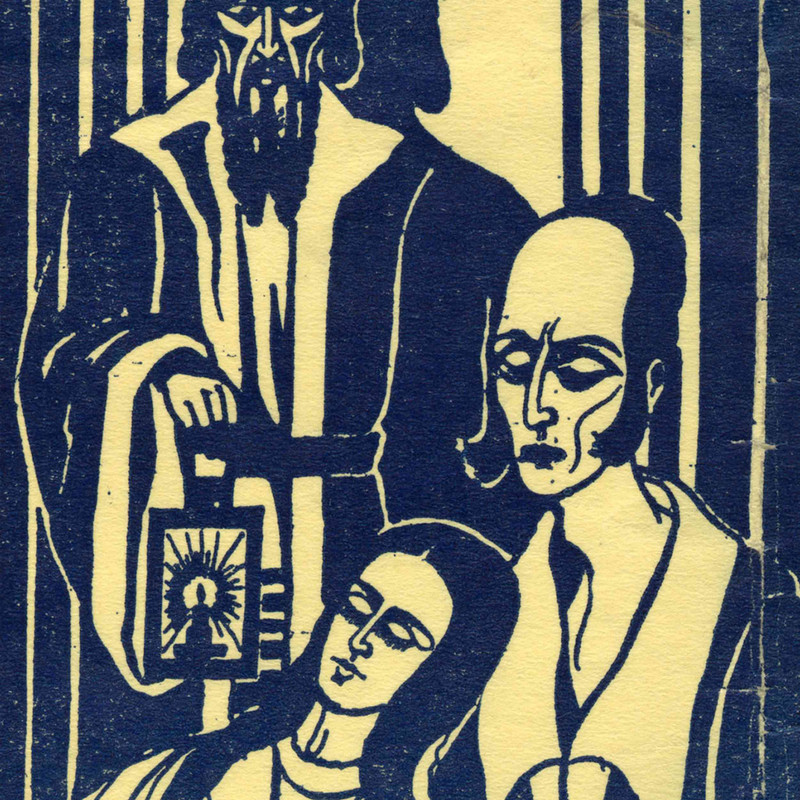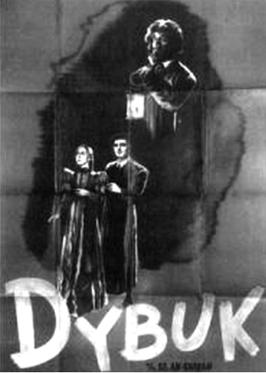
In the early years of film from the silent era to the early talkies there were the major powers; the United States, France, Russia, Germany, Italy, maybe Britain plus Sweden and Denmark, the film output of which is well known and documented. Then there's the second rank of smaller powers, largely outside the West, usually smaller and/or less wealthy, such as China and Japan, India, some Latin American countries and countries in Eastern Europe including Finland and the Baltics (which I wrote about last month), Romania and Greece that made some interesting films that may have gone unnoticed in the outside world but offer a look at different cultures adapting to the new medium. Among these are the Yiddish films mostly made in Russia in the twenties and Poland in the thirties.
Setting aside the "Assimilated" who may have lived in Jewish neighbourhoods but otherwise were fully integrated into the larger non-Jewish societies in which they lived, speaking the local languages (German, French, English), doing business and attending the same theatres as Gentiles, the Jewish communities in Europe fell into two categories; the Ghetto, neighbourhoods in large cities, and the Shtetl, farm villages in rural areas. The population in the Ghettos ranged from ultra Orthodox Hasidic who never left the area and barely interacted with outsiders to the more secular who had business, political, personal and artistic relations with the larger gentile society while the Shtetl were Orthodox, conservative and insular. Both groups used Yiddish as their main language day-to-day if not exclusively and this was reflected in their theatres, media and music. From the mid-nineteenth to mid-twentieth centuries virtually every mid-to-large city in central Europe and North America had at least one large Yiddish theatre holding regular programs of plays, comedies and musicals entirely in Yiddish with big and loyal audiences. In North America a circuit of Yiddish theatres ran separate from the regular vaudeville circuit with the names such as the Marx Bros, Ritz Bros, Edward G Robinson (real name Emanuel Goldenberg), Paul Muni (Fredrick Meirer Weisenfreund), George Gershwin (Jacob Gershvin), Al Jolson (Asa Yoelson) and Eddie Cantor (Isadore Itzkowitz) getting their start in Yiddish theatre before crossing over to Vaudeville, Broadway and Hollywood. However when a Yiddish film industry began it would happen in Europe, which had a less integrated society and a smaller film industry. A small but quite active Yiddish film industry sprang up, originally centered in Russia which had a large European Jewish community, both Ghetto and Shtetls combined but after the Great War and Russian Revolution much of the action moved to the by then independent Poland which had the largest Jewish population in Europe outside the USSR.
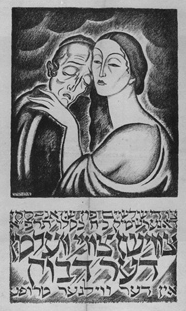
DYBBUK POSTER
The vast majority of the plays shown in Yiddish theatres were fairly lighthearted fare being various comedies, romances and musicals dealing with life either in the urban Ghetto or small town Shtetl and early Yiddish films would continue this tradition with the first silents being comedies of various types. The most important of which were "Jewish Luck" (Yiddish name "Idishe Glikn") made in Russia in 1925 about a petty dreamer with various get rich quick schemes which was adopted from a play written by Sholem Aleichem who also wrote the original "Fiddler On The Roof" and "Laughter Through Tears" (AKA "Durkh Trennan", 1928) about a boy trying to find ways to support his family. Both films are still extant with the latter film in a version that was clumsily dubbed after sound films came in a few years later.
While the bulk of these films seem pretty similar in consisting mostly of gentle comedies and musicals one film was notable for its darker and more mystical themes and more artistic visuals influenced by German Expressionism even leaving it be be considered the first (and last) Yiddish supernatural horror film; "The Dybbuk" in 1937. The title character of "The Dybbuk" was a creature from Jewish mythology who was a shape-shifting spirit who could take possession of a human body. The dybbuk was a fairly obscure figure until popularized by a modern Russian/Jewish writer.
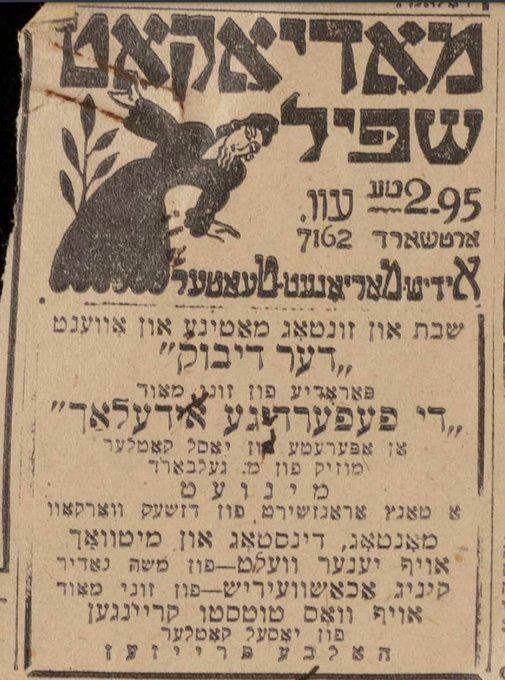
DYBBUK POSTER
Shloyme Zaynvi Rapoport (1863-1920) who often wrote under the name S Ansky was born in Russia where he was busy as a writer, literary critic and folklorist writing in both Russian and Yiddish. He was also a member of the radical Socialist Revolutionary Party who were rivals of the Bolsheviks and like many other radicals he spent much of the 1900's in exile (including Lenin, Stalin and Trotsky) in France and Switzerland where he continued to write articles and edit publications in Russian, Yiddish and French. He returned to Russia after the abortive 1905 Revolution after getting a pardon (as he was in exile and not directly involved) and returned to writing and lecturing. His fiction works covered a range of subjects from novels and plays about traditional Yiddish subjects and settings to modern plays (covertly published) that advocated for Marxist revolution. "The Dybbuk" was written in 1913 as a play and was not his only work dealing with the supernatural (he also wrote another play and some poems based on similar themes sometimes referred to as Yiddish Gothic) but it was not exactly representative of the bulk of his voluminous writings much of which was either scholarly or revolutionary. It was, however his most successful and influential play being staged in Russia as well as other parts of Europe and even making it's way to America. However he would not live to see much of this success as the Great War intervened.

SHLOYME RAPOPORT (Alias S ANSKY)
Although his play had been written in 1913 it had not yet been actually staged having been delayed by the war until 1917 when it was scheduled to be performed only to have it's debut delayed once again by the chaos of the Russian Revolution and Civil War. In the first phase of the 1917 Russian Revolution, which he of course supported, he was elected to the first Russian Assembly as a representative of the Socialist Revolutionaries but after the Bolshevik takeover later that year he would flee first to the now independent Lithuania then Poland where he resumed his writing and trying to get his play staged before dying suddenly of a heart attack in 1920 aged only 57. Only months after his death would his play finally be staged, first in Warsaw and then in the Soviet Union in 1922. The first film based on the play would be produced in 1925 in the USSR (now lost) with the classic version made in Poland in 1937 by which time sound films had arrived to Poland.
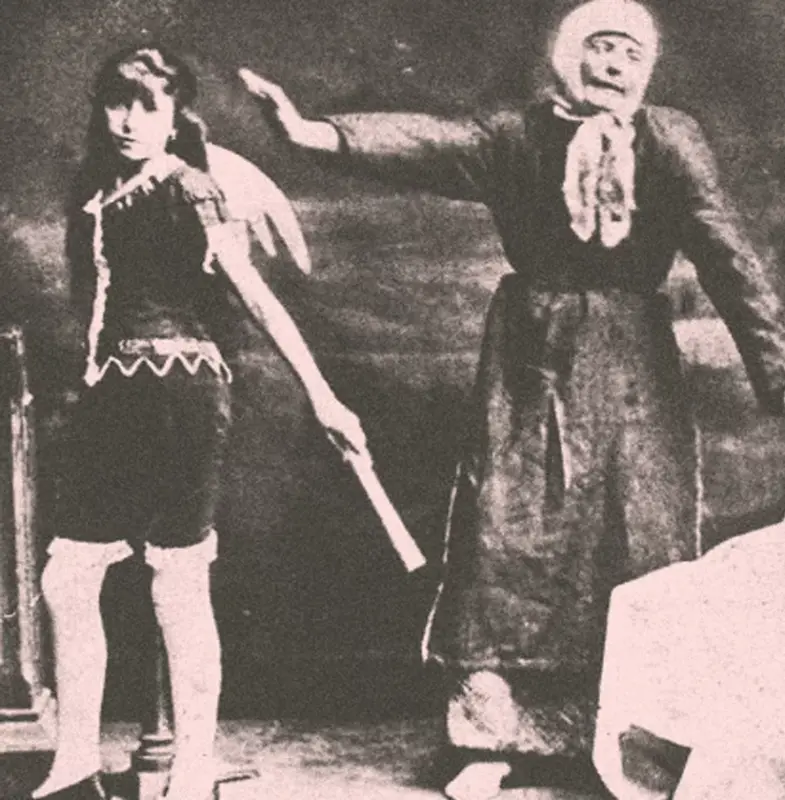
THE ORIGINAL 1920 POLISH PLAY
~~~~~~~~~~~~~~~~~~~~~~~~~~~~~~~~~~~~~~~~~~~~~~~~
"THE DYBBUK" (1937);
Directed by Michal Waszynski
From the play by Shloyme Zaynvi Rapoport as "S. Ansky"
CAST;
Mojzesz Lipman ~ Sender Brynicer Ben Henie
Lili Liliana ~ Leah Sender
Leon Liebgold ~ Channon Ben Nisan
Gerszon Lemberger ~ Nisan Ben Rifke (father of Chanan)
Ajzyk Samberg ~ Meszulach The Messenger (or Seer)
Abraham Morewski ~ Rabbi Azeriel Ben Hodos
Dina Halprin ~ Aunt Frade
Samuel Landau ~ Zalman the Matchmaker
Max Bozyk ~ Nute
Plot synopsis (spoiler alert);
Set in the shtetl of Brinitz in 1800's Russian Pale of Settlement (the area where Jews were largely restricted to, stretching from parts of eastern Lithuania, Poland, Ukraine and western Russia) two friends Sender a Rabbi and Nisan a fisherman make a vow that the children their wives are expecting will eventually marry. They are interrupted by Meszulach, a dark and mysterious travelling seer who warns them against making promises that bind future generations. In the event Sender's wife dies giving birth to their daughter Leah, and at the same time Nisan drowns in a storm at the moment his wife gives birth to their son Channon. Eighteen years later Sender becomes a rich but miserly rabbi, and one day Channon arrives there as a poor yeshiva student to study and Sender offers him lodging while both men are unaware of their connection. Channon has been followed by the Meszulach who appears and fades away is if by magic. He introduces Channon to Sender but does not reveal their secret past to either man. Leah and Channon fall in love, but keep this a secret knowing that Sender will not agree to marriage because of his lack of wealth. Leah shows Channon a grave righ in the town square and tells him it is for a young couple who were murdered on their wedding day and the town center is where wedding recptions so that they may honour the young lovers. Sender tries to make a deal with Zamlan the Matchmaker to find Leah a suitable rich husband with Nachman for his son Menasze but he drives too hard of a dowry bargain and returns home empty handed except for some cattle he bought from Nachman. He finds Leahs singing a song that had only been known by his old friend Nisan. When he asks where she learned the song she tells him she learned it from Chammon whose father had drowned and Sender then realizes Chammon must be the lost son of Nisan to whom he vowed to wed his daughter. As he ponders this Zalman the matchmaker runs in and tells him that Nachman has agreed to his dowry terms and the marriage can go ahead. Sender disregards his vow to Nisan and agrees to the marriage of Leah and Menasze.
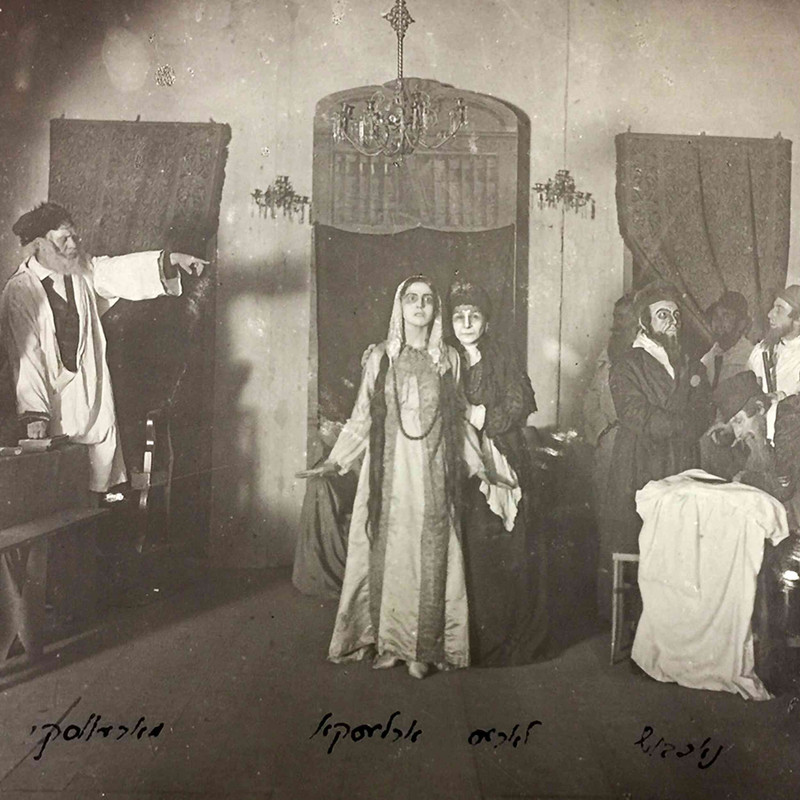
Channon obsessively studies the Kabbalah and attempts to practice magic to stop the marriage and win Leah's hand. When he hears that Sender has arranged Leah's marriage to a rich man's son, he does a rite and calls on Satan to help him but he's struck dead. His friend Nute wanted to warn him but is told by Meszulach that Channon must be allowed to find his own way. After Chammon is buried Leah visits his grave where she is met by Meszulach who tells her about the Dybbuk spirit Chammon had invoked but she does not believe him and prays for him to return. During a bridal celebration dance Leah has a vision of the undead spirit of Chammon who dances with her. As the long wedding ceremony goes on Chammon's spirit rises from the cemetery. Leah breaks away from the wedding vow and throws herself on the grave of the lost lovers in the town square and calls upon Chammon to rescue her. As it starts to rain Meszulach announces that she has been possessed by the Dybbuk. The next day Sender and her Aunt take her to a Rabbinical Council in Miropol for advice. Meszulach is already there and he denounces Sender for his greed and selfishness. The head Rabbi Azeriel also blames Sender who admits he has broken his vow to Nisan. Azeriel convenes a Rabbinical trial in which Senders is found guilty of breaking his vow to Nisan and after accepting judgement is forgiven any punishment allowing the wedding of his daughter to go ahead after Azeriel declares the vow voided. However Meszulach who has attended the trial announces that Nisan does not accept the verdict and the Dybbuk has not departed from Leah's body. Azeriel agrees to perform an exorcism to cast out the Dybbuk and after a ceremony in the Temple she collapses and Azeriel declares the Dybbuk has been exorcised and leaves along with his Rabbis and Sender leaving Leah alone in the Temple. She awakens to Chammon's voice calling to her telling her he has left her body but calls her to join him in the afterlife as his bride. She agrees and collapses on the altar where she is soon found dead by Sender. Meszulach witnessing this declares judgement has been rendered and blows out a candle as the wind blows closed the pages of a holy book. Finis.

~~~~~~~~~~~~~~~~~~~~~~~~~~~~~~~~~~~~~~~~~~~~~
This film stands out from the usual musical and comedy fare of Yiddish films not only in its supernatural and horror themes but also in its artistic ambitions with obvious influences taken from German Expressionism. This can clearly be seen in the hallucinogenic bridal dance scene where the Dybbuk takes the form of Death and dances with Leah. But there are other signs of Expressionist influence particularly in the sets. The town square conjures up the ghetto in Paul Wegener's classic "Der Golem" (itself based on another Jewish mythical creature) if less ramshackle and cluttered while the cemetery, with it's ricketty headstones, all of which appear to be crooked, and the large headstone in the center of town reminds one of the cemeteries in "The Student Of Prague" (1913 with Wegener again and 1926 with Conrad Veidt) and FW Murnau's "Nosferatu". These sets are clearly artificial indoor sets as was standard in the early German Expressionist film although there are scenes on the road that are outdoor shots. The film doesn't make excessive use of Expressionist tropes of shadows, isolated pools of light and stairways going nowhere aside from the conjuring scene which does bring to mind Murnau's "Faust" (1926). Some of the acting employs exaggerated Expressionist gestures, especially among the extras and crowd scenes of various figures standing around staring wide-eyed and open mouthed and during the well edited back-and-forth action during the conjuring scene as a dance is going on while we see a fine shot of Sender sitting all alone and imperious as if on a throne but surrounded by darkness.

Director Michal Waszynski came about his Expressionist influences honestly as he had started out as an assistant director to none other than FW Murnau. Later he would return to a by then independent Poland and become the most prolific film maker in Poland with over thirty films to his credit. In fact he was so ubiquitous that it was estimated, not entirely in jest, that he worked on fully a quarter of the films made in pre WW2 Poland. Ironically, although secular Jewish by heritage with a good working knowledge of Jewish traditions and the Yiddish language by the time of this most classic of Jewish films was made in 1937 he had actually become a Catholic convert. As for Expressionist influences however it's notable that in the surviving stills from the 1920's stage play suggest that it was already seen as an Expressionist presentation and one must remember that Expressionism had started out as a theater movement before graduating to the screen and such figures as FW Muranu himself and started in the theater as had Paul Wegener and Conrad Veidt among others.
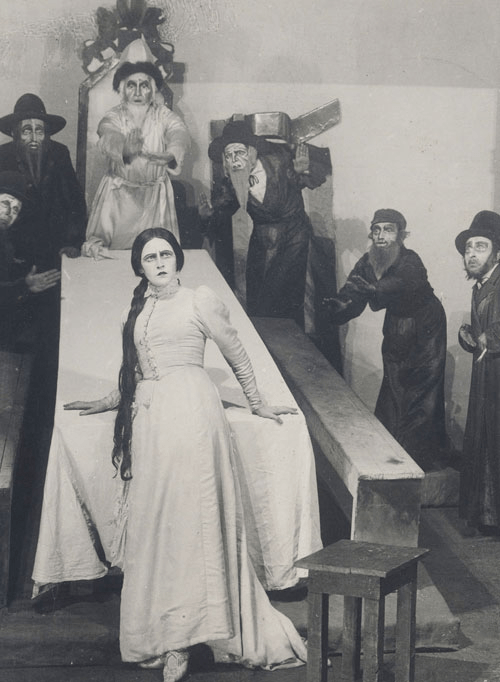
SCENE FROM THE 1920'S STAGE VERSION
This film and play are sometimes somewhat facetiously referred as the only examples of a genre called Yiddish Gothic but they could also be termed Yiddish Expressionism. Speaking of Gothic it's no doubt a coincidence but the theme of a girl being possessed by a demon would be revisited in 1973 classic "The Exorcist", however it's worth noting that the latter film made in the cynical seventies actually has the more positive ending as the demon is cast out and the girl is saved while in the "Dybbuk" the girl dies. On the other hand it was also a fate she chose rather than be saddled in a marriage arranged by her father for clear mercenary reasons to a man she (or for that matter the viewer) does not even know.
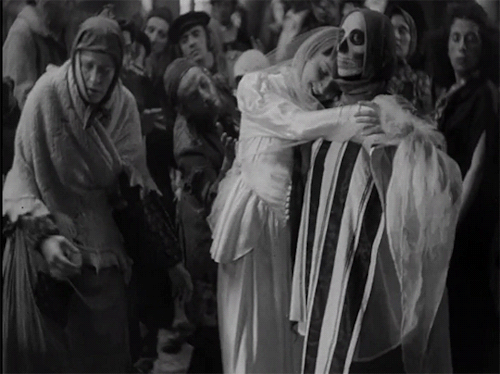
One obvious difference between this film and German Expressionism is it's frequent musical numbers. This is partly because German Expressionism as a film genre (as opposed to it's stage version) was of course a silent film genre but it's also a byproduct of the Yiddish Theatre where musicals were not only popular but ubiquitous much like Bollywood today and audiences would expect music as a matter of course. In the event there are more than a half dozen musical numbers in the film depending on how you want to count them however almost all of them are done in context, as in the song is something the characters would actually be doing such as the wedding dances, religious songs or women singing while they work unlike in Hollywood or Bollywood musicals where musical numbers stop the action while characters break out in song or a big production number then snap back and return to the script which in this case helps to maintain the film's moody and fantastical atmosphere. This dreamlike feel is also enhanced by it's portraying a culture and world very foreign to most modern viewers although it would obviously have been less so to some of its original audience.
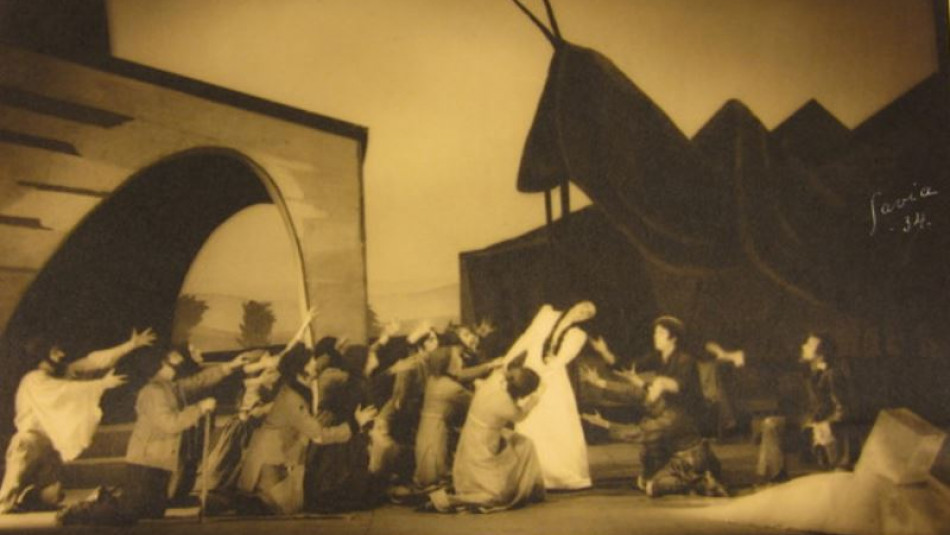
COURTYARD SET FROM THE 1920'S PLAY
While director Michal Waszynski did have plenty of worthwhile experience as well as an artistic and aesthetic vision the film is not without its flaws. Like many early talkies it's slow moving in getting to it's climax, spends a lot of time with characters standing around talking and probably could have done with some more judicious editing. The many musical numbers also slow things down somewhat. The acting is uneven with some cast members (who mostly came from the Yiddish theatre world) notably Lili Liliana (Leah), Leon Liebgold (Channon), Mojzesz Lipman (Sender) and Abraham Morewski (Azeriel) doing perfectly credible jobs while others such as Ajzyk Samberg (Meszulach) and some of the extras, being stiff and wooden or awkward. This is also common in the early Hollywood talkies.

INTERIOR SET FROM THE 1920's PLAY
Essentially this film resembles the films made in the first couple years of the sound era in Hollywood from about 1929 to 1931. It's worth remembering that sound films came to Eastern Europe a few years later than in Hollywood or the large nations of Western Europe meaning filmmakers there would need a couple years to catch up to the new methods and figure out how to direct and tell stories in the new medium so even though it was made in 1937 by Hollywood standards it should probably be seen as roughly equal to a film of about 1931 or 32 which is the timeframe of the classic "Dracula" or the German film "M".
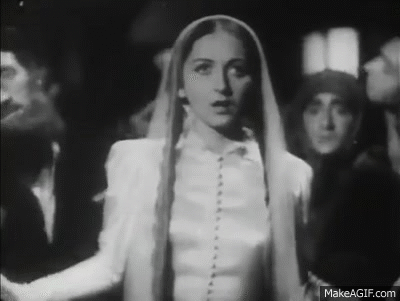
For a film made in Poland with a Jewish cast just before the Nazis came one might naturally fear about the ultimate fates of it's director and cast but somewhat miraculously most of them managed to avoid the Holocaust. Director Waszynski was in Poland when the Germans invaded but he quickly fled east and ended up in the zone occupied by the Soviets to whom he quickly offered his services as a filmmaker and they, always quick to recognize the importance of film as agit-prop put him to work as a theatre director. Before he had the chance to actually make any films for them however the Nazis invaded the USSR and he took the opportunity to escape and join up with the Free Polish Army in the west who were opposed to the Soviets where he would make a film documentary about their fighting in the invasion of Italy. Of course the Free Poles would lose out to the Soviets and he would never return home but ever the survivor he made his way to Italy and eventually Hollywood where he would carry on a successful career as a producer on such major productions as "The Quiet American" (1958), "El Cid" (1961) and "The Fall Of The Roman Empire" (1964) before dying of a sudden heart attack in 1968 aged 60. Lili Liliana (Leah) and Leon Liebgold (Chammon) would actually become a married couple and were touring in America when the war started and they would stay there working mostly in the Yiddish theatre scene with Lili dying in 1989 at the age of 76 while Liebgold would serve in the US Army then also return to the stage where both would have respected careers until he died in 1993 aged 83. They were buried in New York, far from their native Poland but together as in the film.
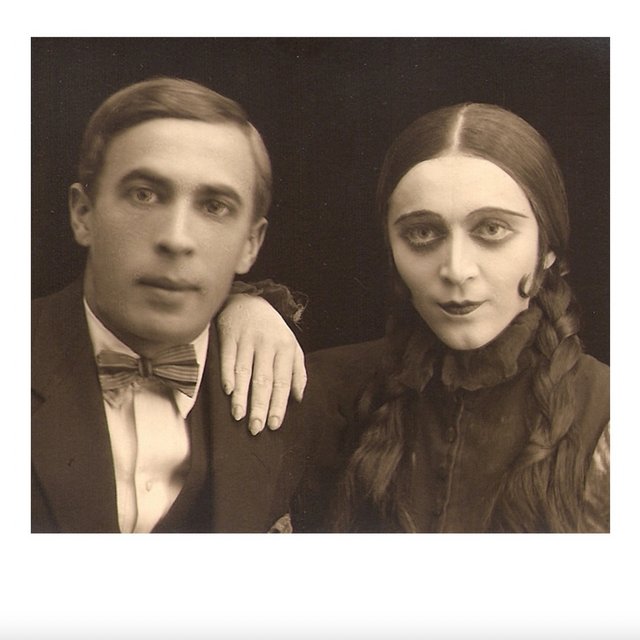
MICHAL WASZYNSKI & LILI LIANNA
Abraham Morewski (Azreiel) survived the war in the Soviet Union to afterwards return to Poland where he returned to the stage becoming an award winning actor and writer dying in 1964. Mojzesz Lipman (Sender) also survived and returned to Poland where he worked as a writer director at least until 1948 when he apparently retired and dropped out of sight. Dina Halprin (Aunt Frade) would also end up in New York where she would have her own respected stage career, dying in 1989. Max Bozyk (Chammon's friend Nute) was yet another who ended up in New York. He had also appeared in two other important Yiddish films "Yidl With His Fiddle" (1936) and "Klies Chaf" (AKA "The Vow" or "A Rabbi's Power", 1937) and would continue his career in Argentina and New York where he died in 1970. Inevitably however some where not so lucky. Samuel Landau (Zalman the Matchmaker) had been acting in film since 1913 including in the same other two films as Bozyk. Trapped in the Warsaw Ghetto he would continue to perform but there would be no escape from the Ghetto where he died in 1942. Ajzyk Samberg (Meszulach the Seer) was caught up by the Nazis and transported to a concentration camp where he reportedly also put on performances for the other inmates until he was murdered by the Nazis in 1943.
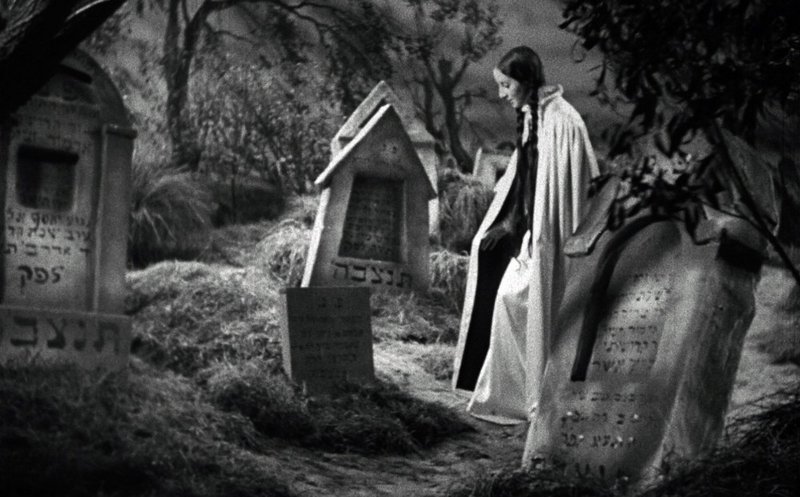
NOTE; The version of this film that most people are familiar with, and the one currently available on Youtube and the Internet Archive, is taken from an old print from the 30's or 40's which is very poor quality both visually and audibly (although it does have English subtitles clearly added around the time of release presumably for a limited American showing) which has given a mistaken impression that this film was more crude than was actually the case at the time of release. But I recently stumbled on a version which has been restored to pristine visual condition and makes it clear that this film was up to contemporary standards of Hollywood and Western Europe so I've uploaded it and it can now be viewed as the filmmakers intended in all its Yiddish Gothic glory. This must be a seperate print from the other as the contemporary English subtitles are gone although someone has added new Spanish subtitles. If you can't pick your way through the Spanish I suggest watching the film twice as I did, once using the poor quality print with English subtiles to get the story and again using the better quality print to see the full visual clarity.
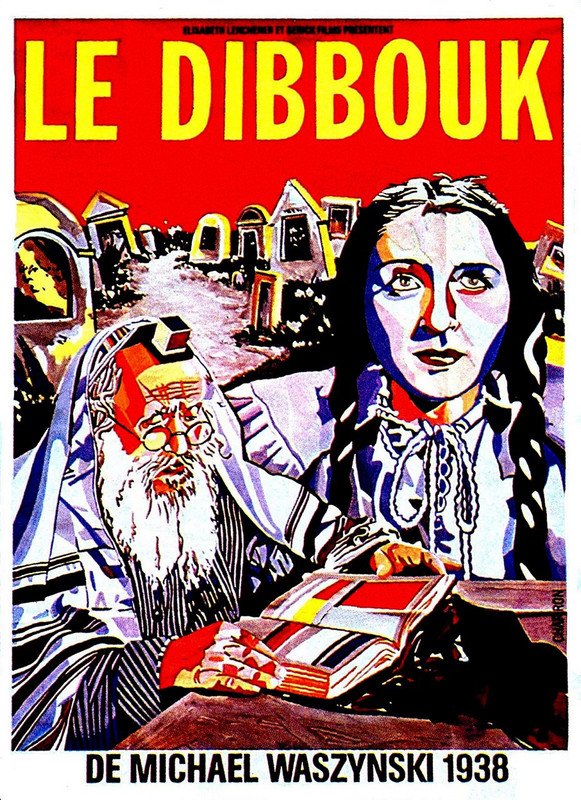
~~~~~~~~~~~~~~~~~~~~~~~~~~~~~~~~~~~~~~~
The status of "The Dybbuk" as the greatest Yiddish film meant it would inevitably be rediscovered and remade and it would eventually be done in English as a made for TV production directed by no less a name than Sidney Lumet.
"THE DYBBUK" (1960);
Directed by Sidney Lumet
CAST;
Theodor Bikel ~ Sender
Carol Lawrence ~ Leah Sender
Michael Tolan ~ Channon
Vincent Gardenia ~ Nissen
Ludwig Donath ~ Rabbi Azriel
Milton Selzer ~ Meszulach the Seer
Sylvia Davis ~ Aunt Frade
~~~~~~~~~~~~~~~~~~~~~~~~~~~~~~~~~~~~~~~~~~~
This was done for a TV series called "Play Of The Week", one of the many anthology shows in the early days of TV with this one having a more artistic bent which included plays by Ibsen, Ben Jonson, Truman Capote, Arch Obler and Mel Brooks. Sidney Lumet had by this time already been nominated for a Oscar for "12 Angry Men" (1957) and as he points out in the intro his father had acted in a stage version in the 1930's so he was no doubt serious and treated this as a work of literature rather than a film. While the 1937 film had influnces from German Expresionism and Yiddish musicals which makes for an unique film Lumet considered himself a Realist who reject such fantasy worlds and this version is simply a stage version which happens to be filmed. It is thus very stagebound with a few spartan sets, all indoors, that have no paticular style, it is also very slow moving. While the 1937 film had some slow patches this one is downright glacial and frankly boring with most of the time taken up by characters standing or sitting around talking. The 1937 film, while not exactly a musical, did have several musical numbers as was was typical of Yiddish theatre at the time while the 1960 version is largely without music which is a little ironic since Lumet himself mentions the importance of music to the culture in his intro. The play clocks in at two hours which was a long time for a TV show in 1960 which also shows how seriously this project was taken but it's really too long. The dialogue is realistic and well acted with a cast made up of prominant stage actors. Theadore Bikel was a respected actor and Carol Lawrence having been nominated for a Tony for "West Side Story" (1957). Also along was a then young character actor Vincent Gardenia. Note while Lumet and most of the cast were Jewish, Lawrence and Gardenia were actually Italian Americans. This 1960's version largely dispenses with the supernatural/occult themes of the 1937 version which by 1960 were probably seen by the educated worldly Lumet and a possible audience as being a little undignified and more suited to a B-Movie horror flick and a distraction from Lumet's attempt to present a literate and humanized portrayal of a culture that he obviously respected to the larger modern secular gentile audience. Ironically dispensing with the Expressionsit smoke & ghostly spirits of the 1937 version means that the departed spirit of Nisan is never actually seen and is instead played by the dissembodied voice of Vincent Gardenia and Carol Lawrence has to play her possession scenes by spinning around, mouth agape with her hands waving in the air before collapsing in a heap both of which might have worked on a small stage but looks inadvertantly silly here. The TV version also lackes entirely the moody Gothic/Expressionist atmospherics of the 1937 film which might have seemed a little corny in 1960 but have dated better than Lumet's wordy melodramatic realism at least in this case. The 1960 version is sincere, has some good dialogue, is well acted and has historical value as being possibly the first portrait of Hasidic culture on mainstream American TV but as a viewing experience it can be safely missed and the 1937 version is vastly better and far more watchable.

As an odd footnote the original play and films were popular enough that they inspired a puppet show version which, assuming it were filmed, has sadly not survived aside from a poster and an intriguing still.
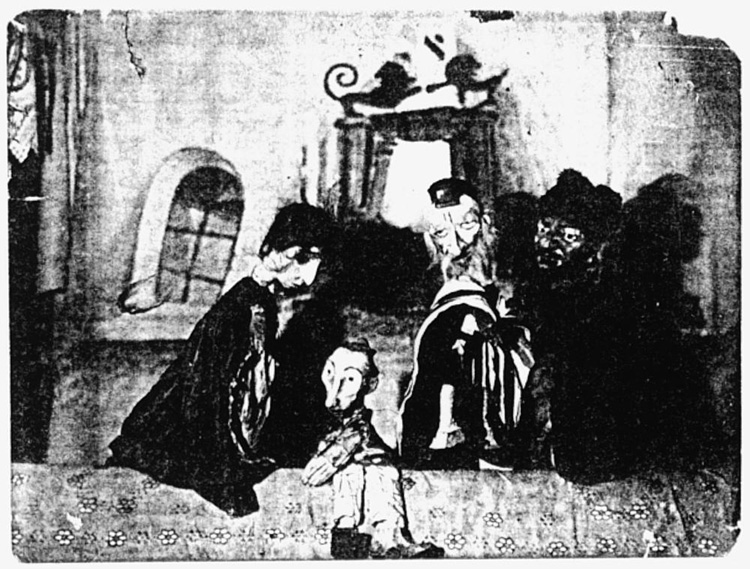
1930's PUPPET SHOW VERSION
~~~~~~~~~~~~~~~~~~~~~~~~~~~~~~~~~~~~~~~~
Besides the 1937 film there was a previous Yiddish film which utilized some of the same themes from the original Rappaport's 1922 play as a silent film made in Poland in 1924.
"TKIES-KAF" (AKA "THE VOW" or "A Vilna Legend" or "The Rabbi's Power", 1924);
Directed by Zygmunt Turkow
From a play by Peretz Hirschbein
CAST;
Zygmunt Turkow ~ Elijah The Prophet
Ida Kaminska ~ Rachel Kornberg
Esther-Rokhi Kaminska ~ Mrs Kornberg
Simcha Balanoff ~ Jacob Mandel
Moshe Litman ~ Baruch Mandel
Lev Mogilov ~ Schmuhl Levine
Henryk Tarlo ~ Levine Jr
Adam Domb ~ Chaym Kornberg
David Ledermen ~ Matchmaker
Jonas Turkow ~ Yeshiva Student
Joseph Buloff ~ The Narrator
Plot Synopsis (Spoiler Alert); In the turn of the century Lithuanian capital of Vilna a group of Hasidic men gather in a tavern. One of them proceeds to tell a story about Elijah, a prophet who wanders from place to place taking the disguises of various figures to influence the affairs of men. In the story Elija comes to Vilna in the form of a wandering beggar. He finds a local Rabbi who is giving advice to the locals. Two of his visitors, merchants Chaym Kronberg and Baruch Mandel are married but childless and the Rabi assures them they will have children when God wills it and they leave. Chaym and Baruch are friends and they share their troubles making a vow that if they do have a son and daughter they will marry them to each other. Elijah witnesses this vow although the two men do not know who he is. Twenty years later Chayam has had a daughter and Baruch a son, however they have lost contact as Mandel has moved away to a town in the country while Kronberg stayed in Vilna where his now poor family are struggling, we learn that Chaym has since died and his ailing wife and daughter have been reduced to selling fruit in the street, taking in washing and working as seamstresses. The couple also had a son who went off to war. Before he died Chaym made a loan to a Russian General by taking valuable jewels as collateral and hiding them in a secret place for safekeeping. One day a telegram arrives informing the family that their son has died in action and after reading the telegram Chaym has a heart attack and dies as well. When the General returns to reclaim his jewels Mrs Kronberg does not know where Chaym had hidden them and to repay the losses she must sell the home and business to another wealthy merchant, Schmuhl Levine thus reducing the family to poverty. Meanwhile Baruch Mandel is a wealthy merchant living in another town and is preparing to send his son Jacob off to Yeshiva school in the city to study. Elijah, still in the disguise of a wandering holy prophet visits and when Baruch asks his advice as to where he should send his son to live within the city he suggests Schmuhl Levine and Baruch agrees. Jacob arrives in Vilna and finds Levine who invites him to stay with his family which includes his own son who is of similar age. Jacob however is sober, religious and studious while Levine's son is worldly, secular, dresses in expensive clothes and likes to drink and smoke. Jacob sees Rachel who he does not know and who lives nearby in a small apartment across a courtyard with her sick mother. As Jacob studies in his room while Rachel and her mother are working on their sewing an old Beggar appears in the courtyard and begins singing for alms. Rachel and Jabob both hear him and toss him some coins. The Beggar blesses them and then vanishes into thin air. Later Jacob is studying at Yeshiva school Rachel and her mother arrive selling apples. Jacob and other students are smitten with Rachel who gives them free apples when they can not afford to pay. Jacob becomes obsessed with Rachel and can not focus on his studies. He dreams and begins to have visions. First as himself and Rachel together in Biblical times. Next two of his school friends come in and act as good and evil spirits. The evil one tempts him by taking him to a burlesque show while the good one takes him to the cemetery where they visit the tomb of the great Ribi of Vilna where he is then locked in. Jacob then wakes up and hallucinates again before returning to his room and going to bed sick. Meanwhile Rachel goes to sell fruit to Schmuhl Levine who is now living in their old house and who has just stumbled on to the Chaym's old hidden cache of jewels. When Rachel shows up Levine, who is much older than Rachel, makes a pass at her and she flees as his son enters. Later Levine Jr has a party and as the merriment carries on Jacob arrives and is invited to stay and does so, captivated by the women there he shyly removes his Hasidic hat. Afterwards Levine Jr gives him a makeover in which Jacob sheds his long Hasidic hair locks. Jacob, now in his new secular clothes borrowed from Levine Jr, Jacob runs into Rachel and the two go off on a walk together. Schmuhl sees them together and notices they are attracted to each other plots to prevent their relationship. He goes to the local Matchmaker and hires him to go to Mrs Kornberg to negotiate a marriage with her daughter. As the Matchmaker is discussing the matter with Mrs Kornberg, Rachel arrives and when told of the marriage proposal from Levine she angrily refuses and storms out. The Matchmaker reports this to Levine who blames her reluctance on the presence of Jacob and he plots to have him removed by writing to Mr Mandel and telling him Jacob has been backsliding in his studies and living a sinful life. Baruch arrives as Jacob is getting dance lessons with Levine Jr and a woman and he furiously orders him to pack his things and return home which he does after writing a goodbye note to Rachel and leaving it with Levine Jr who delivers it to her. She runs after him but is too late. Later Baruch has arranged a proper marriage for Jacob with the daughter of a wealthy merchant and we see him at the wedding reception having returned to wearing his Hasidic clothes. At the signing of the wedding contract Baruch has second thoughts remembering the vow he made to Chaym twenty years earlier but he goes through with signing the contract. During the pre-wedding feast Jacob sits alone depressed over his marriage and missing Rachel. The next day as Baruch heads out to make more wedding arrangements he is warned not to go by a stranger who accosts him on the street and warns him from going but he brushes the stranger off and as he does so the stranger changes form to Elijah and fades away without Baruch noticing. his journey is next interrupted as his horse stops and refuses to go as the invisible form of Elijah is holding the horse's bridle. Angrilly Baruch runs off on foot but misses his train and instead falls and injures himself and is brought home. Baruch is plagued by bad luck forcing him to sell some of his businesses which include a lumber yard and while he is showing it to a perspective but he is almost struck by a falling tree and is convinced he has seen the woodcutter before. The falling tree killed a bird who had been in her nest and unseen by Baruch the woodcutter scoops her up and breathes life into the bird before changing form back into Elijah and disappearing.
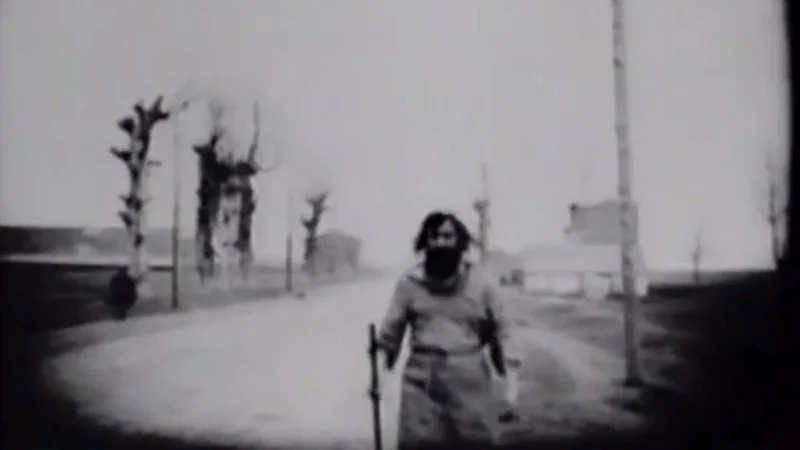
That night as Baruch is sleeping he is visited by the spirit of Chyam who reminds him of his vow to marry his son Jacob to his daughter rachel. Suddenly Baruch is woken by the news that a forest fire has broken out and he has to flee but as he does he sees a vision of himself and Chaym making their vow for their children's marriage and he collapses. Meanwhile the Matchmaker has returned to the Kornbergs to convince Rachel to marry Levine. Again she refuses as she is waiting for Jacob to return so the Matchmaker shows her the news that Jacob is to be wed and she collapses. With Rachel depressed and refusing to leave her bed Levine hires a doctor to examine her and he prescribed time in the country air so Levine pays to send her to a country sanitorium to recover where he follows and again proposes marriage and this time she wearily agrees. Mother and Daughter visit Chaym's grave to pray for guidance and help. That night Rachel dreams that the spirits from the cemetery rise from their graves and come to dance at her wedding where Jacob appears as her groom only to suddenly turn into Levine and she awakes screaming that she will never marry Levine. Baruch has returned home and deciding he must stop the wedding he rushes off to Vilna. Jacob arrives home where he is told by his mother about Rachel's wedding but not that his father has rushed off to try and stop it. On the wedding day Rachel is depressed while Levine throws a wedding feast which Elijah attends now in the disguise of a wealthy merchant. Levine invites him to stay and the Chief Rabbi recognizes him as being a holy man. As the wedding is about to start Baruch arrives and stops it telling everyone about his vow with Chaym. Jacob rushes in and insists he has the right to marry Rachel and Elijah says their wedding is blessed dismissing Levine and the wedding guests who meekly comply leaving Rachel and Jacob alone with Mrs Kornberg, Baruch and the Rabbi. That night Elijah visits Levine in a vision and orders him to give the jewels to the Rabbi so he can return them to Mrs Mrs Kornberg. Elijah and the Rabbi visit the Kornbergs who are at home with Jacoba and Baruch and return the jewels then Elijah vanishes. The Rabbi now realizes who Elijah actually was and Baruch many of the men he had met who had tried to influence him to keep his vow (the Woodcutter, a coachman etc) were all actually Elijah in disguise. He is relieved to have kept his vow and gives his full blessing to the wedding of Rachel and Jacob. Elijah is shown returning to his true form as an old wandering beggar and leaving Vilna. We return to the men in the tavern as the Narrator finishes the story. Finis.

~~~~~~~~~~~~~~~~~~~~~~~~~~~~~~~~~~~~~~~~~
While this film shares some obviously similar themes to "The Dybbuk" and can also be considered an example of Yiddish Gothic there are some notable differences. While "The Dybbuk", at least the film version, is essentially a supernatural Gothic romance with religious undertones "The Vow" is a religious film with supernatural Gothic romance undertones, thus the focus is different as is the intent. "The Dybbuk" is Gothic and fatalistic, "The Vow" is conservative and reassuring. "The Vow" is presented from the start as a religious parable about the importance of keeping a sacred vow and a virtuous religious life with the main supernatural character being a Biblical prophet with a clear moral message. The message here is clear and even simplistic; Chaim and Baruch made a sacred vow in the presence of Elijah the Prophet and so Baruch must keep his word even if the original vow was impulsive and not well thought out or for that matter entirely fair since it's not Baruch's fault that Chaim moved away and lost contact and further neither man could know the were making the vow in the presence of Elijah in the first place since he was in disguise. Still keeping the vow is clearly in the best interest of the Kornbergs and it's obviously what Jacob wants so while Elijah may be taking things a little literally he's doing what's right in the end. By contrast in "The Dybbuk" Chamon summoning a demon to win over a bride even unto death seems a little obsessive if not stalkerish. In "The Vow" the Chief Rabbi recognizes who Elijah is and defers to him in maintaining community standards while in "The Dybbuk" the Chief Rabbi fails to fully understand the true nature of the spirit and thus fails in his exorcism. Note the subtitle of this film as "A Rabbi's Power" is a little ironic as he clearly is not the main power here, however well intentioned.
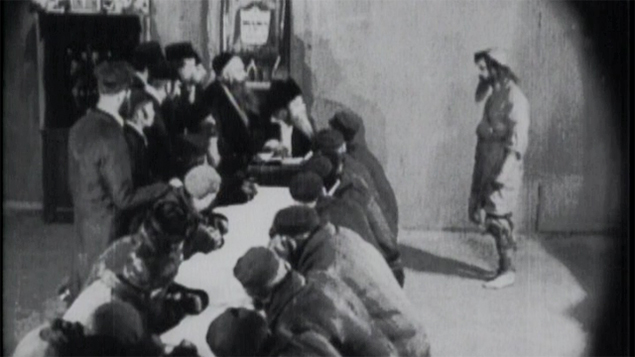
ELIJAH MEETS THE RABBIS
This film itself has an odd history. Originally filmed in 1924 Poland by actor/director Zygmunt Turkow, who also appeared in it as Elijah, as a silent. Like other Yiddish films it probably made its way to other European countries with substantial urban Jewish communities such as Germany, Romania and eventually America as well. By the sound era in 1933 American Jewish director George Roland re-released it as a sound version with a new voice-over narration in Yiddish by actor Joseph Buloff as well as adding English subtitles, removing the original Yiddish intertitles and changed the title to "A Vilna Legend". He may have also made some other edits but more importantly he also filmed new opening and closing framing sequences being those set in the tavern with the men sitting around while one (Buloff) tells the story and narrates while the others act as Greek chorus periodically throughout the film. These scenes were seemingly added to make the film more relatable to modern American Jewish viewers who may have found the mystical imagery old-fashioned. By doing so however this has the effect of undermining those themes by removing the viewer from the story somewhat by presenting it not as a immersive fantasy, as most Gothic and Expressionist films are, and instead as a story told by a narrator who is not entirely reliable as he is clearly telling a tall-tale fable. The obvious comparison is the 1920 German film "The Cabinet Of Dr Caligari" where director Robert Wiene (apparently prodded by the studio) added opening and closing scenes which many thought changed and even undermined the supernatural and political themes of the script by framing the entire story as a tale told by a clearly unreliable narrator, in that case an inmate in an asylum.
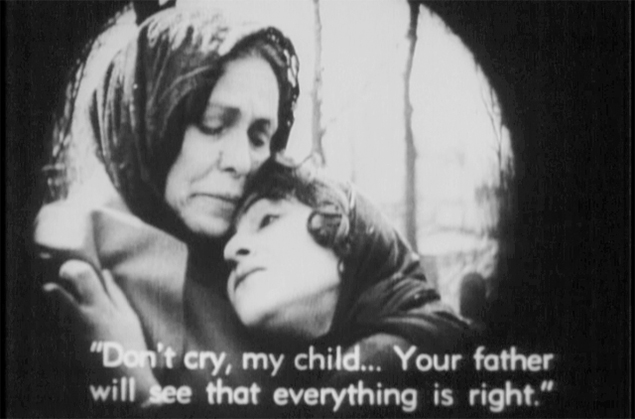
The new narration by Roland actually takes the religious message and imagery and makes it more preachy as it strains to point out how Jacob has "taken the first step" towards sin by first shedding his hasidic clothes and then his long hair-locks before (gasp of horror) taking dancing lessons, and from a woman no less. Clearly Roland was not prepared to risk having the viewer figure this out themselves but he may have gone further than Tutkow's original version intended. In Roland's voiceover the character of Levine's son is explicitly presented as lapsed, sinful and a bad influence of Jacob pointing out that he "never prays" and prefers to smoke and party with girls (gasp again) and when Levine makes a pass at the much younger Rachel, the Narrator sniffly says he is "like father like son". However that is not really fair to him as in the actual film we see Levine treats Jacob quite well. In the beginning when his cronies mock Jacob's provincial ways he dismisses them and takes him home, he includes him in his fun, doesn't mock him, when Jacob is summoned home he packs for him and when entrusted with a letter for Rachel he does deliver it and when Levine Sr makes a pass at Rachel it is Levine Jr who interrupts so saying he is "like father like son" is just wrong. He may be a frivolous adolescent who would rather party than study but he is a loyal friend to Jacob. Somewhat inconsistently at the end when Jacob rushes off to stop Rachel's wedding, by which time he had already been dragged home by his father for lapsing from the Hasidic ways, he is still wearing his fashionable secular clothes although in the end he has changed back. The original film is not shy in using other obvious religious imagery as when Jacob is shown being tempted and distracted from his studies by Rachel literally using an apple as if she were Eve in the Garden Of Eden.

RACHEL VISITS JACOB AT THE SCHOOL
At any rate besides making these changes Roland also changed the opening credits naming himself as sole director and snubbing Turkow entirely which was rather unethical and probably legally actionable by Turkow even in the somewhat lax copyright laws of the era, unless Roland purchased the full rights to the film. Making changes to silent films, even substantial ones, was not unusual at the time, "Metropolis" is a case in point, and once the the sound era began the most silent films became worthless so doing so with a film with such a specific audience would not be that unusual, although taking a full directors credit is another matter. This is assuming Turkow even fully knew about it at the time. However in 1933 he was still in Poland where he would remain until the Nazis invaded in 1939 when he was able to flee to Brazil. After the war he moved to Israel where he continued his stage career so if he ever heard about the 1933 rerelease and its changes he may have felt it not worth pursuing especially for a film using by then obsolete technology and for an inherently limited audience. In addition in 1937 while still in Poland, Tutkow himself did a completely remade sound version (also in Yiddish) to good reviews which still survives. The 1937 version (in which he again cast himself as Elijah) somewhat mutes the supernatural themes in favour of focussing on the more conventional romance. Ironically after all this long and winding road the print now extant has lost it's voiceover soundtrack while stll having the added scenes and subtitles so in the end the film now survives as a silent anyway.

Visually the film is pretty conventional for the most part but it does has a few nicely Gothic and Expressionist touches as the dead rising from their graves wrapped in prayer shawls to descend on the wedding is classically Gothic and the scene where Jacob is taken to a fantasy burlesque to be tempted by dancing girls could almost be from an early German "Street Film" if it had been done with a bit more flair, while the scene with Jacob being lured to the cemetery and locked in could come from one of Victor Seastrom's Swedish films. There are a couple attempts at comedy as well (both oddly involving food) that are at odds with the tone of the rest of the film. There are a few other scenes with Elijah appearing and vanishing which are echoed in "The Dybbuk" in the Messenger character. The cemetery doesn't have the Expressionist moodiness of "The Dybbuk" and in fact none of the sets are especially noteworthy unlike in classic Expressionist films and are instead presented more or less realistically. Director Turkow did not have the same experience as "Dybbuk" director Waszynski or for that matter even George Roland, in fact this would be his first film and he would only direct one more as well as acting in three others but he may not have the experience or esthetic vision as one working in a decade earlier in a new medium, he does an effective job here and most of the clunkier aspects of the story telling are really the result of changes made by Roland.

Like "The Dybbuk" this film was based on a play although often compared to the better known latter film with which it shares some obvious similarities "The Vow" was in fact older both as a film and a play. Written in 1907 by Peretz Hirschbein, who was also a Jewish writer in Tsarist controlled Poland. Unlike the more secular Rapoport he had a religious upbringing and education and somewhat unusually he would not only write in Yiddish but also in Hebrew, then considered a more scholarly language rarely used for contemporary literature. Unlike the wide ranging Raporport who wrote a lot of non fiction scholarly and political activist works Hirschbein concentrated on fiction writing stories, poetry and especially plays and he founded his own theatre company which became highly influential in Eastern in promoting Yiddish theatre as having legitimate drama asidefrom the usual musicals and comedies. He also travelled through much of Europe and to the Americas where he settled in New York just before the Great War. During that war and while on a transatlantic trip the ship he was on was sunk by a German U-Boat and was captured by the Germans who dropped him off in Brazil where he managed to make his way to Hollywood, where he resumed his career. He'd live to see the end of the Third Reich dying of Lou Gehrig's disease in Los Angeles in 1948 aged 67.

PERETZ HIRSCHBEIN
As in "The Dybbuk" most of the cast survived the Holocaust. As mentioned Turkow ended up in America where after a respected theatre career on four continents he died in 1970. Besides casting himself in a role of Elijah he also cast his wife, Ida Kaminska, as Rachel and her screen mother would be played by her real life mother Esther-Rokhi Kaminska. Turkow and Ida would be divorced in 1932 (the year before Roland's 1933 rerelease) and she would end up having an even more successful career than her ex-husband.
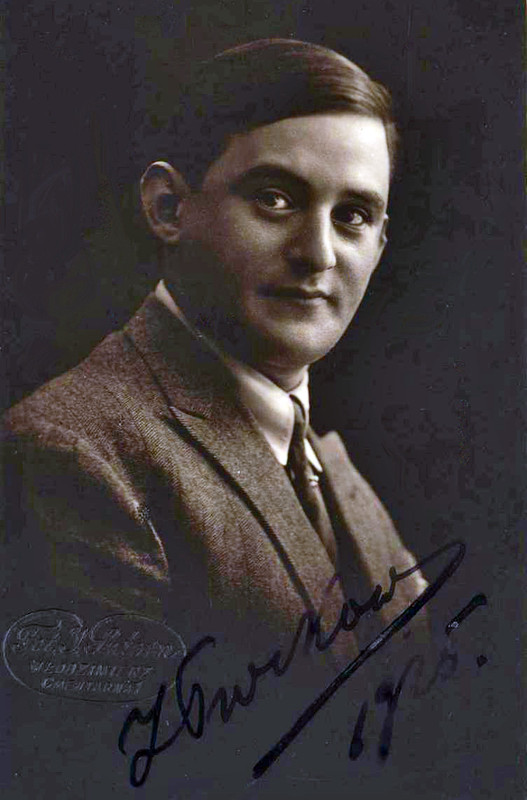
ZYGMUNT TURKOW
She remarried and also fled Poland during the war, in her case to the USSR, but returned to rebuild the Yiddish theatre and acted in films earning an unusual Oscar nomination in 1967 for the Czech film "The House On Main Street". She left Eastern Europe for good after the 1968 and yet another Soviet invasion and moved to America where she became a mentor to what remained of the American Yiddish theatre in New York where she died in 1980. Her mother Esther, born in 1870, had been a respected actor in Tsarist Poland and Lithuania since the 1890's known as the Yiddish Eleanor Duse. She made a few other short films but this was her only feature film made before she died in 1925 aged only 55.

IDA KAMINSKA
Ironically Turkow's second wife Diana Blumenfeld was also an actress who played a small role in this film which raises some eyebrows in retrospect, she died in 1961 New York. As if to make things more complicated (not to mention incestuous) Turkow also cast his younger brother Jonas as Jacob's Yeshiva school friend and Jonas would also marry Diana Blumenfeld. He ended up in Israel where he died in 1988 aged 90. At least one member of the cast, Samuel Landau, who plays a minor role here, would also appear in "The Dybbuk" a decade later. David Lederman, who plays the Matchmaker, would later appear in one of the last notable pre-war Polish Yiddish films "Kol Nidre" in 1939 and he fled to Argentina where he was still active into the 1950's.

ESTHER KAMINSKA
As for director George Roland, he claimed to have worked as a film editor since before the Great War although actual proof of this is spotty at best. During the 1930's he carved out a successful, if somewhat shady sideline in taking silent films, usually with Biblical themes, and re-editing them with new voiceovers and rereleasing them as educational or religious films under his own name as he had with "The Vow". While this may not have been exactly ethical, some of his versions are the only surviving copies of these films. A tireless hustler to the end he promoted himself as a director although he actually worked mostly as an editor on various unknown projects although he may have made various typically uncreditted educational and industrial short films before he died in 1961.
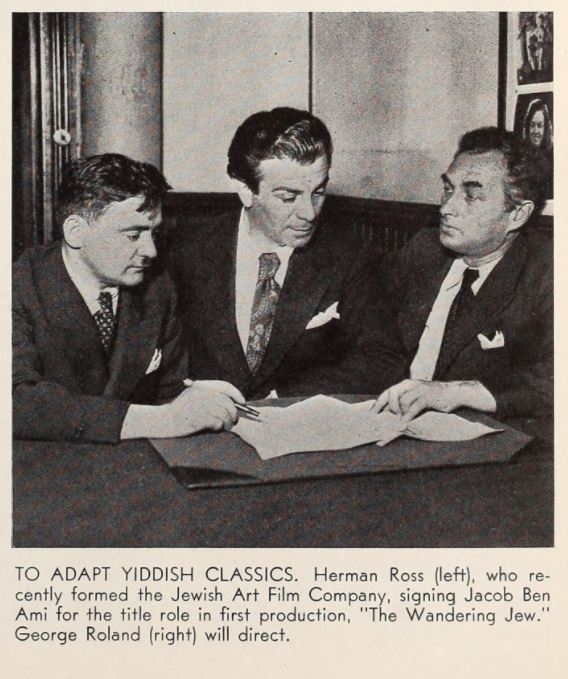
GEORGE ROLAND & FRIENDS
Joseph Buloff, who played the Narrator in the Roland version, would have the longest carrer in film and theatre career both in the Yiddish theatre and on television and Hollywood in such TV series as the popular sitcom "The Goldbergs", crime show "The Naked City", medical drama "Ben Casey", supernatural anthologies "Lights Out", "Suspense" and "Tales Of Tomorrow" and films "Somebody Up There Likes Me" (1956) and "Silk Stockings" (1957) and finally an appearance Warren Beatty's 1981 epic "Reds" before dying in 1985 aged 86.

JOSEPH BULOFF
If Yiddish Expressionism is indeed a film genre version of Yiddish Gothic theatre these two films may well be the only examples of it and they would certainly make for a unique Halloween/Yom Kippur double feature.

THE DYBBUK IN WOODCUT FORM;
